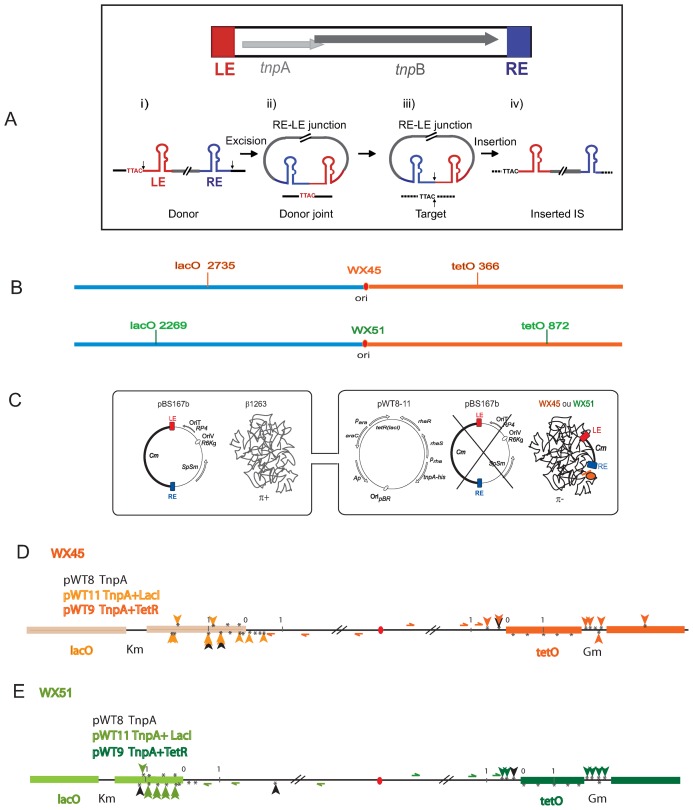Figure 1.
IS608 insertion into blocked chromosome replication forks. (A) IS608 and its transposition pathway. IS608 organization. Top: the left (LE) and right (RE) IS ends are shown in red and blue respectively. Grey horizontal arrows: tnpA and tnpB; red and blue boxes, LE and RE ends (colour code retained throughout). Transposition pathway. Bottom (i) schematized single-stranded IS608 showing secondary structures of LE and RE, the flanking TTAC and cleavage positions at the IS ends (vertical black arrows). (ii) Excision and formation of circular ssDNA with an RE–LE transposon junction and a sealed donor joint (black line) retaining the TTAC. (iii) TnpAIS608 brings together the transposon junction with a new target DNA (dotted black line) carrying the required target TTAC. The two black arrows indicate points of cleavage and strand transfer. (iv) Insertion of IS608 into the target flanked on the LE by TTAC. (B) Position of the lacO and tetO arrays in Escherichia coli WX45 and WX51: the replication origin, ori, is shown as a red ellipse and the Left and Right replicores in blue and orange respectively. E. coli WX45 and WX51 contain arrays at different locations. (C) Experimental system: the cartoon represents the suicide mating strategy used to isolate insertions. The left side of the figure shows plasmid pBS167b, used as the IS608 donor plasmid. It is replication proficient in the donor strain by virtue of a copy of the π replication gene inserted into the donor chromosome. pBS167b is unable to replicate following conjugal transfer to the transposition test strain since this strain lacks the π gene. This is shown in the recipient strain on the right side of the figure. Three alternative plasmids were used in the recipient strain: pWT8 (carrying tnpA alone under control of the prha promoter); pWT11 (a pWT8 derivative including lacI under control of the para promoter); or pWT9 (a pWT8 derivative including tetR under control of the para promoter). Transposase and either LacI (pWT11) or TetR (pWT9) were induced in the recipient prior to mating. Following mating, the cognate inducers were added to release LacI or TetR respectively from the operator arrays and relieve the replication barrier permitting cells to resume growth before plating. (D and E) Insertions into E. coli WX45 and WX51: details of the lacO array (light orange or light green rectangles) on the left replicore and of the tetO array (orange or green rectangles) on the right replicore. Black vertical arrows: insertions obtained in the absence of LacI or TetR. Green or orange vertical arrows: insertions obtained in the presence of LacI or TetR in several independent experiments. The positions of the oligonucleotides (not to scale) used to localize the insertions are shown with half arrowheads. The kanamycin and gentamycin resistance cassettes used in the construction and insertion of the lac and tet operator arrays are also shown. * represents potential TTAC target sequences present in the region, 0 represents the beginning of arrays and 1 is distance in kb.

